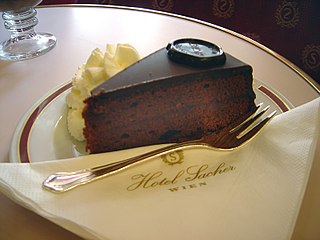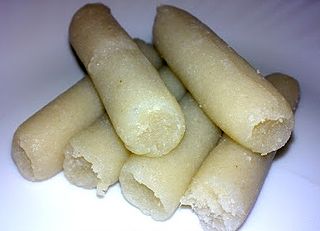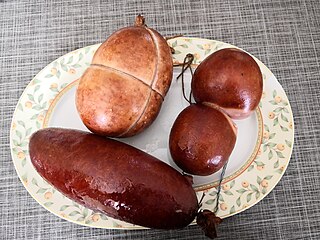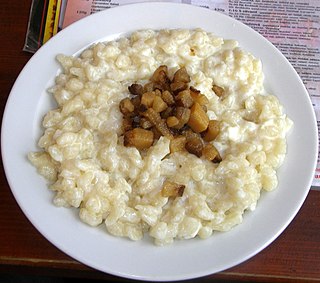
The cuisine of Germany consists of many different local or regional cuisines, reflecting the country's federal history. Germany itself is part of the larger cultural region of Central Europe, sharing many culinary traditions with neighbouring countries such as Poland and the Czech Republic. In Northern Europe, in Denmark more specifically, the traditional Danish cuisine had also been influenced by German cuisine in the past, hence several dishes being common between the two countries.

A pickert is a flat, fried or baked potato dish from Westphalia, Germany. It can be considered a kind of flattened dumpling or very nourishing pancake. It comes as a round Pfannenpickert the size of a pan, a rectangular Kastenpickert, or a palm-sized regular Pickert. The name is derived from Low German picken, pecken.

Pierogi are filled dumplings made by wrapping unleavened dough around a filling, and occasionally flavored with a savory or sweet garnish and cooking in boiling water.

Rachael Domenica Ray is an American cook, television personality, businesswoman, and author. She hosted the syndicated daily talk and lifestyle program Rachael Ray. Other programs to her credit include 30 Minute Meals, Rachael Ray's Tasty Travels, $40 a Day, Rachael Ray's Week in a Day, and the reality format shows Rachael vs. Guy: Celebrity Cook-Off and Rachael Ray's Kids Cook-Off. Ray has written several cookbooks based on the 30 Minute Meals concept, and launched a magazine, Every Day with Rachael Ray, in 2006. Ray's television shows have won three Daytime Emmy Awards.

Sachertorte is a chocolate cake, or torte, of Austrian origin, invented by Franz Sacher, supposedly in 1832 for Prince Metternich in Vienna. It is one of the most famous Viennese culinary specialties.

Mock turtle soup is an English soup that was created in the mid-18th century as an imitation of green turtle soup. It often uses brains and organ meats such as calf's head to duplicate the texture and flavour of the original's turtle meat after the green turtles used to make the original dish were hunted nearly to extinction. In the United States, mock turtle soup eventually became more popular than the original dish and is still popular in Cincinnati. The soup is also a traditional dish in the Lower Saxony areas of Germany, where it is considered a specialty of English cuisine.

Aligot is a dish made from cheese blended into mashed potatoes that is made in L'Aubrac region in the southern Massif Central of France. This fondue-like dish from the Aveyron department is a common sight in Auvergne restaurants.

Ají is a spicy sauce that contains ají peppers, oil, tomatoes, cilantro (coriander), garlic, onions, and water. It is served as a condiment to complement main dishes, most oftentimes in Latin American cuisines, and prepared by blending its ingredients using a food processor or blender. Although ají sauce recipes can vary from person to person, there are generally country-specific and region-specific varieties.

Persimmon pudding is a dessert pudding made with persimmons. There is a lot of variety in the recipes, some are made with eggs, others add sweet potatoes or pumpkin. There's no set recipe, although common ingredients include some type of cornmeal or flour, brown sugar or molasses, and spices like cinnamon, nutmeg and ginger. Owing to the difficulty of preparing the pulp from wild American persimmons, persimmon pudding is mostly a regional specialty of the Cuisine of the Midwestern United States.

Brittle is a type of confection consisting of flat broken pieces of hard sugar candy embedded with nuts such as pecans, almonds, or peanuts, and which are usually less than 1 cm thick.

A Dutch baby pancake, sometimes called a German pancake, a Bismarck, a Dutch puff, Hooligan, or a Hootenanny, is similar to a large American popover.

Bobotie is a South African dish consisting of spiced minced meat baked with an egg-based topping.

Baye-Baye is a Filipino dish made from grated young coconut mixed with either newly harvested rice (pinipig) or corn and shaped into patties. It is a specialty of Pavia, Iloilo.

Crispy pata is a Filipino dish consisting of deep fried pig trotters or knuckles served with a soy-vinegar dip. It can be served as party fare or an everyday dish. Many restaurants serve boneless pata as a specialty. The dish is quite similar to the German Schweinshaxe.

Flurgönder is a specialty meat in the Fulda country of Hesse, Germany. It is a raw, smoked brawn, served warm with noodles. It is called "Flurgönder" because it is served in particular in the Catholic region around Fulda and the Rhön after the processions through "field and meadow" for Ascension and Corpus Christi. "Gönder" is a vernacular term for the regional and seasonal specialties, each butcher has his own recipe. It is prepared in hot but not boiling water, ten minutes for every cm of diameter, and is served together with noodles, usually with bread crumbs, a green salad or apple sauce.

Mie kocok, is an Indonesian beef noodle soup, specialty of Bandung city, West Java. The dish consists of noodles served in rich beef consommé soup, kikil, bean sprouts and bakso, kaffir lime juice, and sprinkled with sliced fresh celery, scallion and fried shallot. Some recipes might add beef tripe.

Traditional foods are foods and dishes that are passed on through generations or which have been consumed for many generations. Traditional foods and dishes are traditional in nature, and may have a historic precedent in a national dish, regional cuisine or local cuisine. Traditional foods and beverages may be produced as homemade, by restaurants and small manufacturers, and by large food processing plant facilities.

















